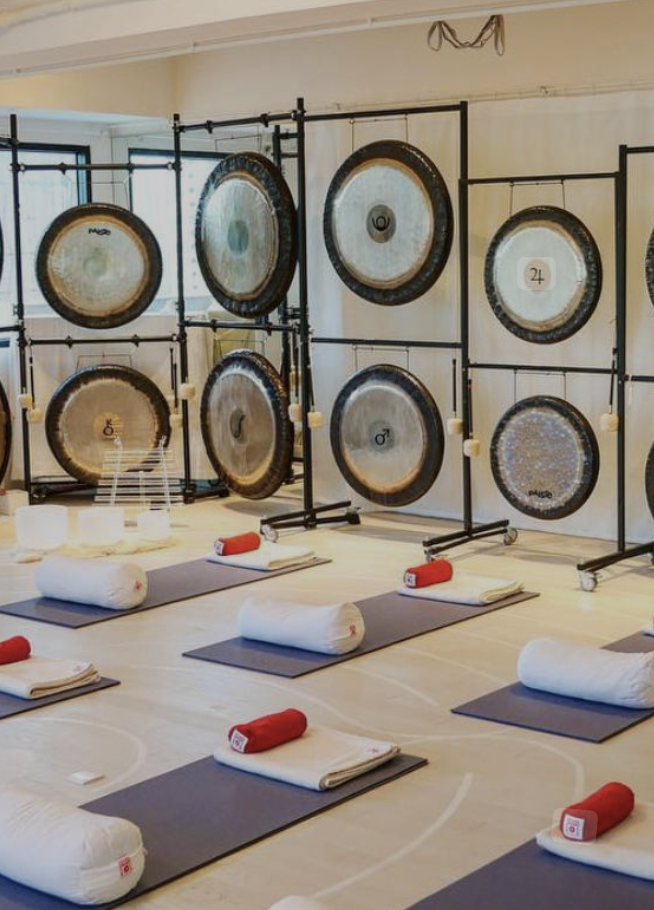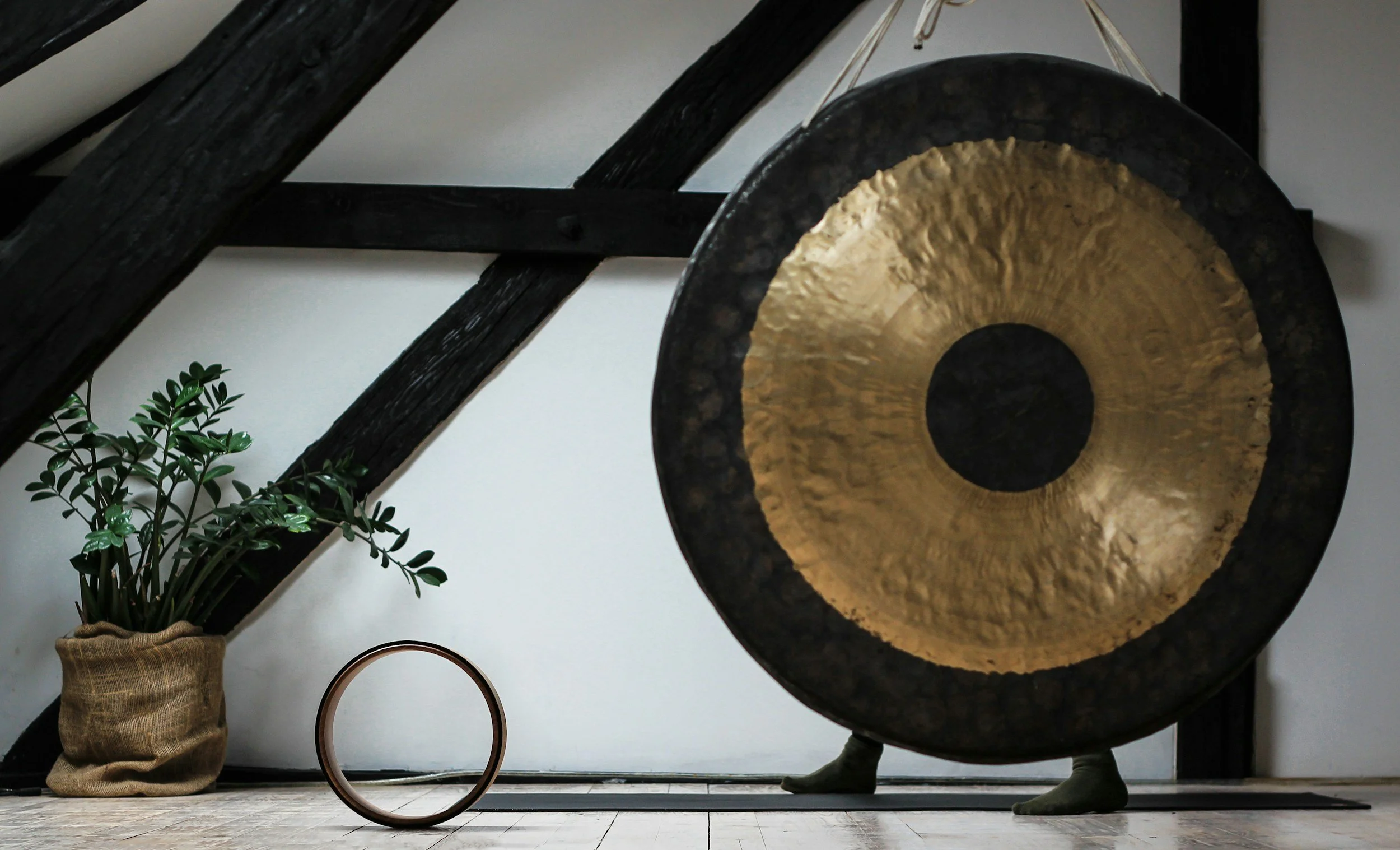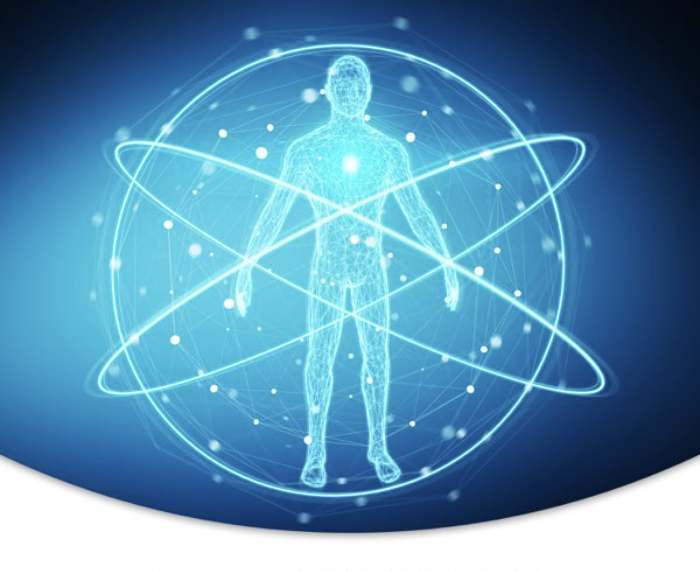Experience the Healing
Power of Sound
80 year old vintage E4 singing bowl.
Step into a space where vibrations from singing bowls, gongs, drums, and tuning forks gently harmonize your body, mind, and energy. Sound healing isn’t just soothing—it can shift your brainwaves, ease tension, and support your body’s natural capacity to heal and restore balance.
Experience the Healing Power of Sound
• Reduce Stress & Anxiety: Deep vibrations help calm the nervous system, lowering stress hormone levels.
• Release Energy Blocks: Frequencies resonate with your energy system, clearing stagnation and promoting flow.
• Enhance Sleep & Relaxation: The mind naturally shifts into restorative states, helping you unwind and recharge.
• Support Physical & Emotional Well-Being: Even a short session can help the body align, supporting immune function and emotional resilience.
“Immerse yourself in the sound that transforms - tradition says it opens energy channels and heals body and mind - modern science proves it works.”
- Hannah Winget
The human body is composed of roughly 55–75% water, and you can actually watch how a singing bowl sets water into motion with its gentle vibrations. That same resonant energy moves through you, encouraging balance and supporting your body’s natural healing process.
Tradition Meets Today
The Origins of Sound Healing: nope, its Not a New-Age Panacea
Sound healing is an ancient practice embraced in cultures across the globe. From the snow-capped Himalayas to the deserts of the American Southwest, communities have long turned to sound as a gentle yet powerful form of medicine. Tibetan singing bowls, Indian gongs, Native American drums, and other shamanic instruments have been used for centuries to nurture physical vitality, emotional balance, and spiritual connection.
These traditions draw on the universal language of vibration, tone, and rhythm to influence the body’s natural energy fields. Slow, sustained notes can calm the nervous system, while layered rhythms can lift energy and clear stagnant patterns. Over time, this interplay of sound helps guide the mind and body back toward equilibrium, inviting a deep sense of harmony and well-being that modern science is only beginning to understand.
• Brainwave Entrainment: Rhythmic auditory stimulation can induce neural oscillations in the alpha (8–12 Hz) and theta (4–8 Hz) ranges, associated with deep relaxation, meditative states, and enhanced cognitive flexibility.
• Autonomic Nervous System Effects: Mechanical vibrations and harmonic frequencies stimulate parasympathetic activity, downregulate sympathetic arousal, and reduce circulating cortisol and catecholamines.
• Binaural & Bilateral Beats: Presentation of slightly different frequencies to each ear (binaural) or alternating ear stimulation (bilateral) can influence thalamocortical coherence, mood regulation, and interhemispheric communication.
• Physiological Benefits: Sound-induced vibration can enhance microcirculation, promote erythrocyte separation, influence lymphatic flow, and support systemic cellular resonance, potentially modulating inflammatory responses and immune function.
Modern Scientific Perspective:
“Even just 10-20 minutes of immersive sound can produce measurable psychophysiological
& physiological effects.”- Hannah Winget
The human body vibrates like a musical instrument, and harmonized frequencies support health.
Intentional sound—voice, music, or instruments—can align body vibrations and promote healing.
Brainwave entrainment and meditation can induce expanded states of consciousness through rhythmic sounds.
Instruments like didgeridoos, Tibetan bowls, and violins can calm the nervous system and stimulate whole-brain coherence.
Sound science may revolutionize medicine, using targeted frequencies to restore balance and even fight disease naturally.
The Top 10 Benefits of Sound Healing
-
Lower stress and improved circulation give the immune system room to work efficiently. Research links sound-based relaxation with higher natural-killer-cell activity.
-
Higher HRV reflects a flexible, resilient nervous system. Sound therapy encourages the rhythmic balance that supports long-term heart health.
-
Rhythmic patterns and specific frequencies help synchronize brainwaves. Participants frequently notice sharper concentration and better memory after sessions.
-
Pleasant soundscapes stimulate dopamine release, lifting mood naturally. Over time, this promotes steadier emotions and greater stress tolerance.
-
Immersive sound encourages a meditative state where many feel more centered and connected—to themselves, others, or something larger. This subtle but profound shift supports lasting well-being.
-
The stress hormone.
Sound meditation and music therapy consistently lower cortisol, the body’s main stress hormone. Less cortisol means a calmer nervous system and improved overall health.
-
Gentle vibration and harmonics activate the parasympathetic “rest-and-digest” response. Many participants report feeling lighter and more relaxed within minutes.
-
Slow, resonant tones help the brain shift toward alpha and theta waves, the same states linked to deep rest. This often translates into more restorative sleep and easier bedtime routines.
-
Low-frequency sound can reduce the perception of pain by releasing endorphins and calming overactive nerves. Clinical studies show measurable improvements in chronic and acute discomfort.
-
Regular sound sessions gently guide the cardiovascular system toward balance. Heart rate and blood pressure often drop as muscles release tension.
Medical Applications
& Emerging Research:
Oncology (Cancer Care):
Researchers are exploring sound therapy as a complementary (not replacement) treatment for cancer patients. Early studies suggest it may help reduce anxiety, pain perception, and emotional stress while improving overall quality of life. Some investigations also show changes in cellular stress markers (the chemical signals in the body that indicate how stressed or inflamed cells are).
Blood Flow & Circulation
(Live Blood Microscopy):
In some small experimental studies, practitioners have used live blood microscopy (viewing a drop of blood under a special microscope in real time) before and after a sound bath.
• Before sound immersion, blood cells often show rouleaux formation (when red blood cells stick together in stacks, like a roll of coins). This can indicate sluggish blood flow and lower oxygen delivery.
• After sound immersion, researchers observed improved erythrocyte morphology (meaning the red blood cells returned to a healthier, rounder shape and were more separate from one another). This suggests sound vibration may temporarily enhance circulation and oxygen transport.
Check out these two live videos demonstrating this effect:
1. Live Gong Meditation
2. Recorded Gong Meditation
Neurological & Psychological Effects:
Sound therapy is also studied in relation to the brain and nervous system. For example, binaural beats (two slightly different frequencies played in each ear) can create a perceived third tone in the brain, which may encourage specific brainwave states linked to relaxation, focus, or sleep. This bridges ancient practices with modern neuroscience and psychoacoustics.
Cellular-Level Research (Quantum Resonance):
A growing area of interest is whether resonant sound frequencies can influence cells directly. For instance, some lab research is testing how focused sound waves can disrupt cancer cells or support tissue regeneration. While much of this is preliminary, it echoes the ancient idea that “everything vibrates” and that health is about restoring harmonious resonance.
“Sound therapy bridges centuries of traditional practice with evidence-informed neuroscience and quantum biology.”
- Hannah Winget
View Video>>
Quantum & Vibrational Perspective
• Everything is vibration: Quantum physics tells us that matter isn’t solid in the way our eyes suggest. At the subatomic level, particles behave more like waves of energy than fixed objects. This means that you, me, the chair you’re sitting on — everything is a dance of vibration and frequency.
• Resonance & entrainment: When one vibrating system encounters another, it can “entrain” — syncing up in rhythm or frequency. This is why a tuning fork can cause another nearby fork to vibrate without touching it. Sound Healing works in a similar way: carefully chosen tones and rhythms can invite your body, brain, and nervous system to shift into more harmonious patterns.
“Sound Healing isn’t just mystical poetry — it lines up with how modern physics describes reality at its most fundamental level.”
- Hannah Winget
• The body as an energy field: From a quantum perspective, the body isn’t just flesh and bone; it’s an electromagnetic system. Brain waves, heart rhythms, and even cell membranes all generate measurable frequencies. Sound Healing leverages this by introducing external vibrations that interact with the body’s internal frequencies, nudging them back toward balance.
• Wave-particle duality made practical: In physics, light and matter can act as both particles and waves. Sound Healing rides the wave side of this duality — using patterned vibrations as “information carriers” that can influence the biological and energetic systems of the body.
Why does this matter in healing?
Stress, trauma, and illness often show up as disharmony — irregular rhythms in the nervous system, chaotic brainwaves, or cellular imbalance. Sound can reintroduce coherence, reminding the body of its own ability to self-regulate and heal.
“Frequency, vibration, and resonance interact with neural, cellular, and energetic systems, influencing mental, emotional, and somatic states.”
- Hannah Wingate
Resources & References:
Articles:
• Verywell Mind: Does Sound Healing Actually Work?
• Psychology Today: The Healing Power of Sound as Meditation
• National Institutes of Health: Sound Waves Aid Brain Tumor Treatment
• ResearchGate: Effects of Sound Immersion on In Vitro Blood Cells
Video / Demo:
• Live Blood Results After a live 20-minute Gong Meditation
• Live Blood Results After a 10-minute recorded Gong Meditation
• How “Tibetan” Singing Bowls are made by hand













